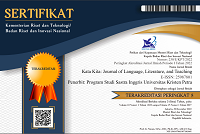A Multimodal Critical Discourse Analysis of Samsung’s Ingenius, Website, Consumers’ Comments, and Samsung-Apple Brand Positioning
(1) Petra Christian University, Jl. Siwalankerto No.121-131, Siwalankerto, Wonocolo, Surabaya
(*) Corresponding Author
Abstract
This study analyzed Ingenius video advertisement. Ingenius is a video advertisement produced by Samsung. However, Samsung only shows its competitor’s product (Apple IPhone X) from the beginning until the end of the video. The video is divided into seven segments and was analyzed by using both Multimodal Discourse Analysis and Critical Discourse Analysis three-dimension framework by Fairclough. This study is expected to find how the Apple IPhone X is represented by Samsung in their Ingenius video advertisement, to find the Ingenius messages according to Samsung’s website, to see the reaction of its consumers, and to find how the brand positioning of Samsung and Apple in the society. Multimodal Discourse Analysis is used to analyze the inner dimension of the framework by using Ingenius video advertisement as the text or discourse. The second dimension is analyzed by using the official Samsung explanation from its website about the video to see the meaning of each segment from the producer to consumers and using the YouTube comments to see how the consumers of the video (viewers) react after watching the video. The outer dimension sees the brand positioning from online newspapers, websites, and blogs to see how the society perceives Apple and Samsung as smartphone brands.
Keywords: Multimodal Discourse Analysis (MDA), Critical Discourse Analysis (CDA), Advertisements, Discourse.
Full Text:
PDFReferences
Carroll, P. (2019, January 22). Apple iPhone X: Top performer for stills.
Retrieved from https://www.dxomark.com/apple-iphone-x-top-performer-stills/
Cohen, Efrat K. “Facial Expressions – The Art of Non-Verbal
Communication.” Everyday Power, 12 Mar. 2019, everydaypower.com/facial-expressions-the-art-of-non-verbal-communication/.
Dash, A. G. (2018, August 10). (UPDATED) All Samsung Ingenious Ads. Retrieved from https://www.youtube.com/watch?v=WzqXzYGN-gs).
Dilger, D. E. (n.d.). The secret of Apple's success in selling premium tech as an affordable luxury. Retrieved from https://appleinsider.com/articles/18/12/19/the-secret-of-apples-success-in-selling-premium-tech-as-an-affordable-luxury
Eichenwald, K. (2017, September 19). The Great Smartphone War: Apple vs. Samsung. Retrieved from https://www.vanityfair.com/news/business/2014/06/apple-samsung-smartphone-patent-war
Jewitt, C. (2009). The Routledge Handbook of Multimodal Analysis. London: RoutledgeFalmer.
Kress, G. (2003). Literacy in the New Media Age. London: Routledge.
Kress, G. &Van Leeuwen. (1996). Reading Images: the Grammar of Visual Design. London: Routledge.
Fairclough, N. (1995). Media Discourse. London: Edward Arnold.
Fairclough, N. (2003). Analysing Discourse: Textual Analysis for Social Research. London: Routledge.
O’Halloran, K. L., Tan, S., Smith, B. A. & Podlasov, A. (2011). Multimodal Analysis within an Interactive Software
Polhemus, T. (1994). Streetstyle: From Sidewalk to Catwalk. London: Thames and Hudson, Inc.
Rehm, L. (2019, January 22). Samsung Galaxy S9 Plus review: Premium specs, top-end performance. Retrieved from https://www.dxomark.com/samsung-galaxy-s9-plus-review-premium-specs-top-end-performance-2/
Searle, John R. (1976) Speech Acts. London: Syndics of the Cambridge University Press
Suzuki, D. (2019). The Nature of Things: The Seven Universal Emotions We Wear on Our Face.
Titscher, S. Meyer,M. Wodak, R. (2000). Methods of Text and Discourse Analysis: In Search of Meaning. London: Sage Publications.
VanLeeuwen, T. (2005). Introducing Social Semiotics. London: Routledge.
Wodak, R. (1998). The Discursive Construction of National Identity. Edinburgh: University Press.
DOI: https://doi.org/10.9744/katakita.7.3.411-426
Refbacks
- There are currently no refbacks.
Supported by:
Indexed in:
Tools:
Stats (installed since 17 December 2018)
View My Stats













